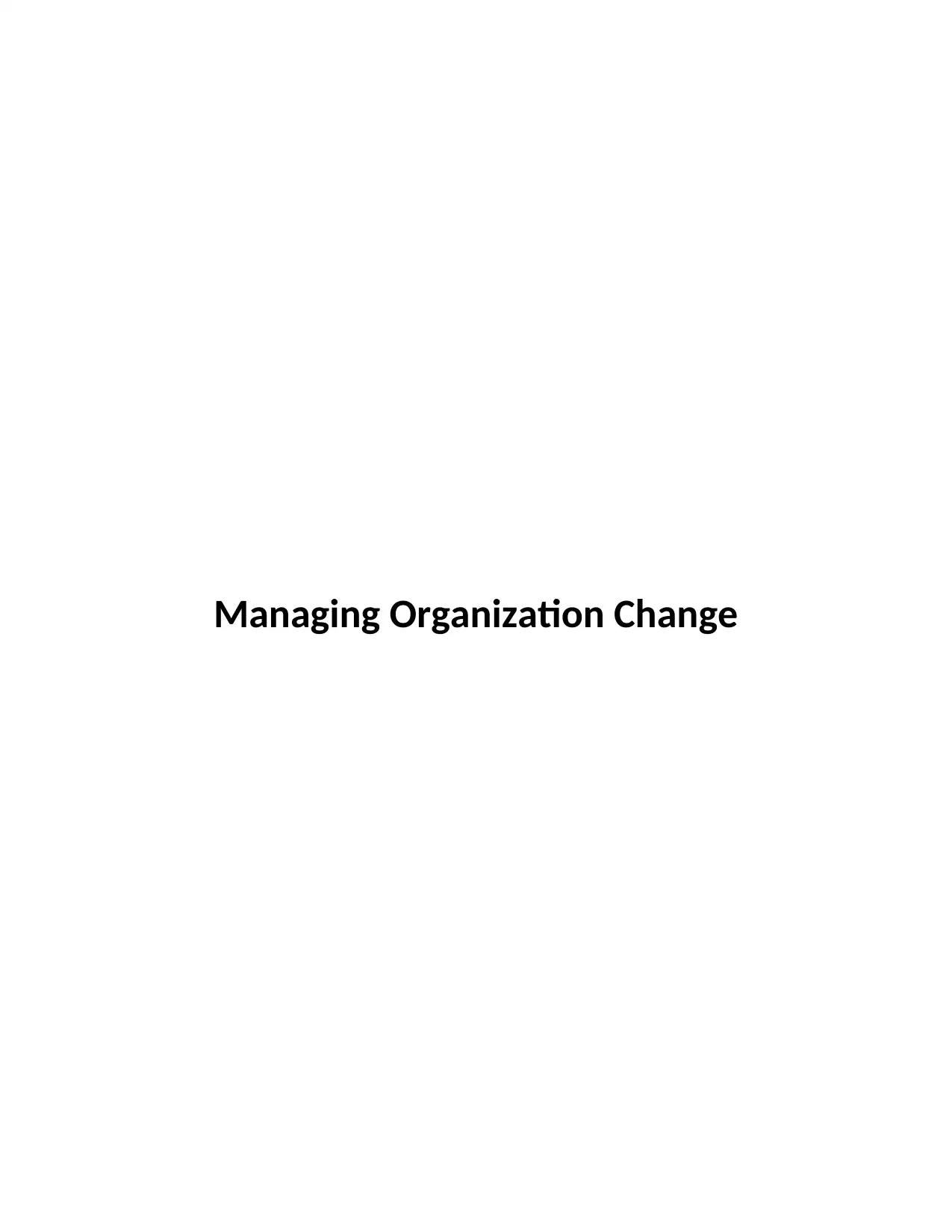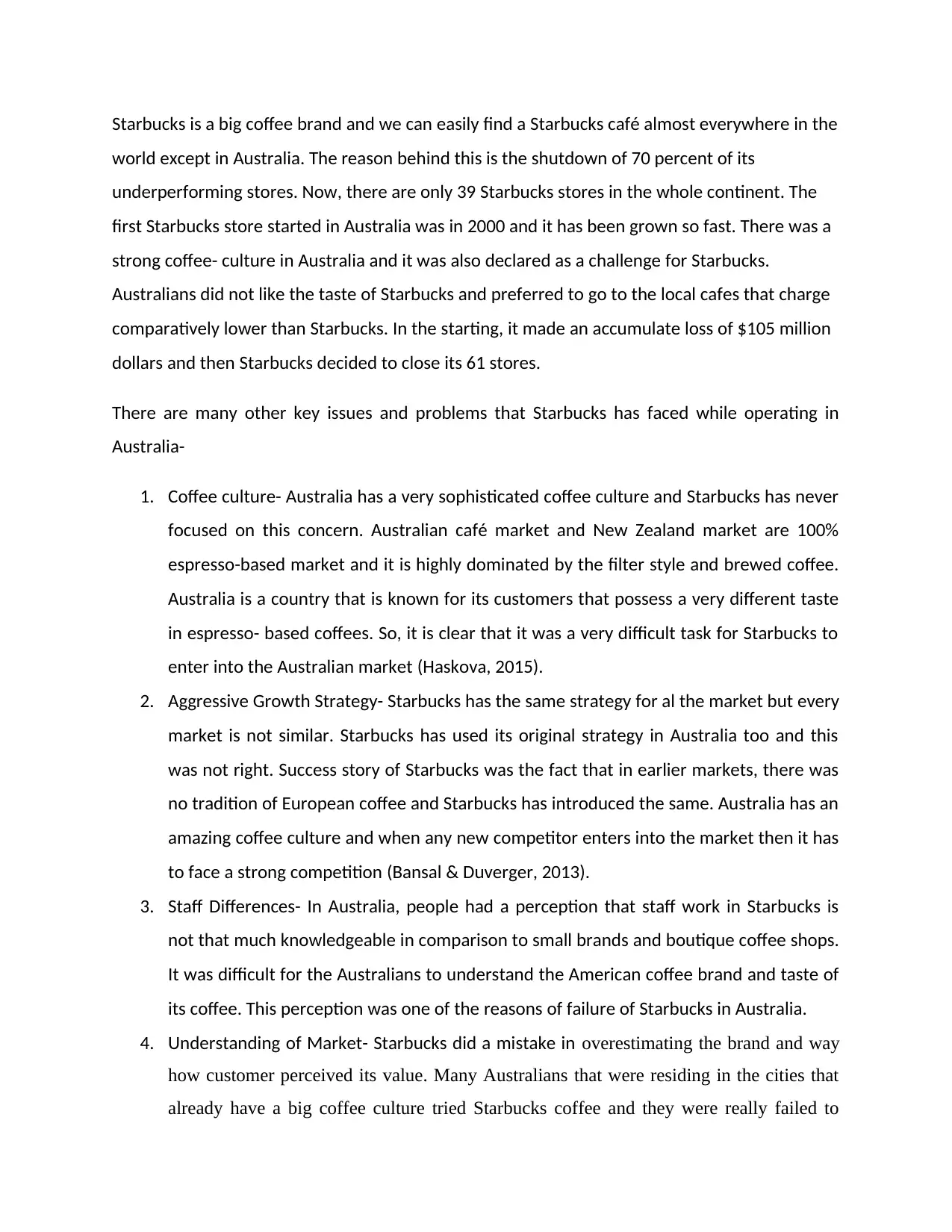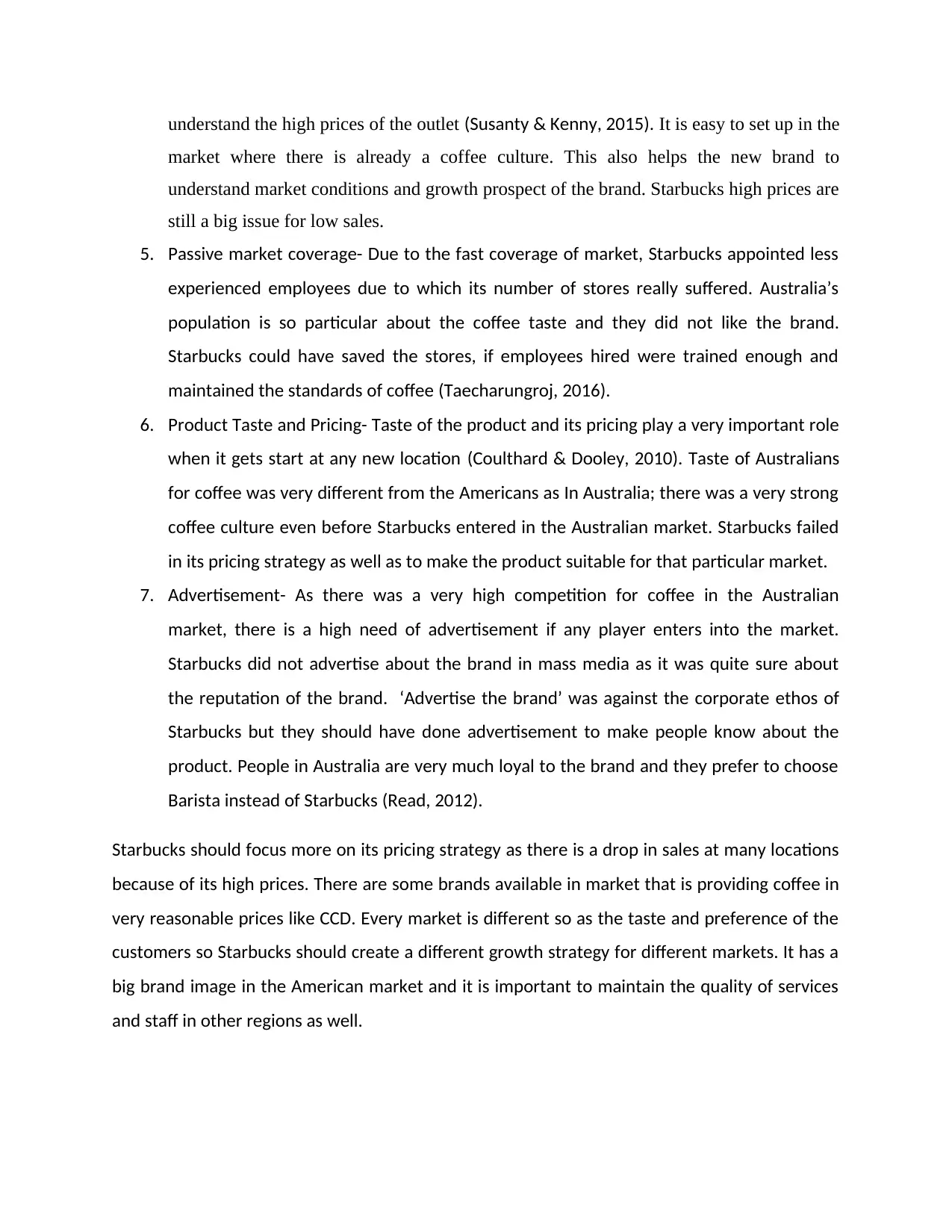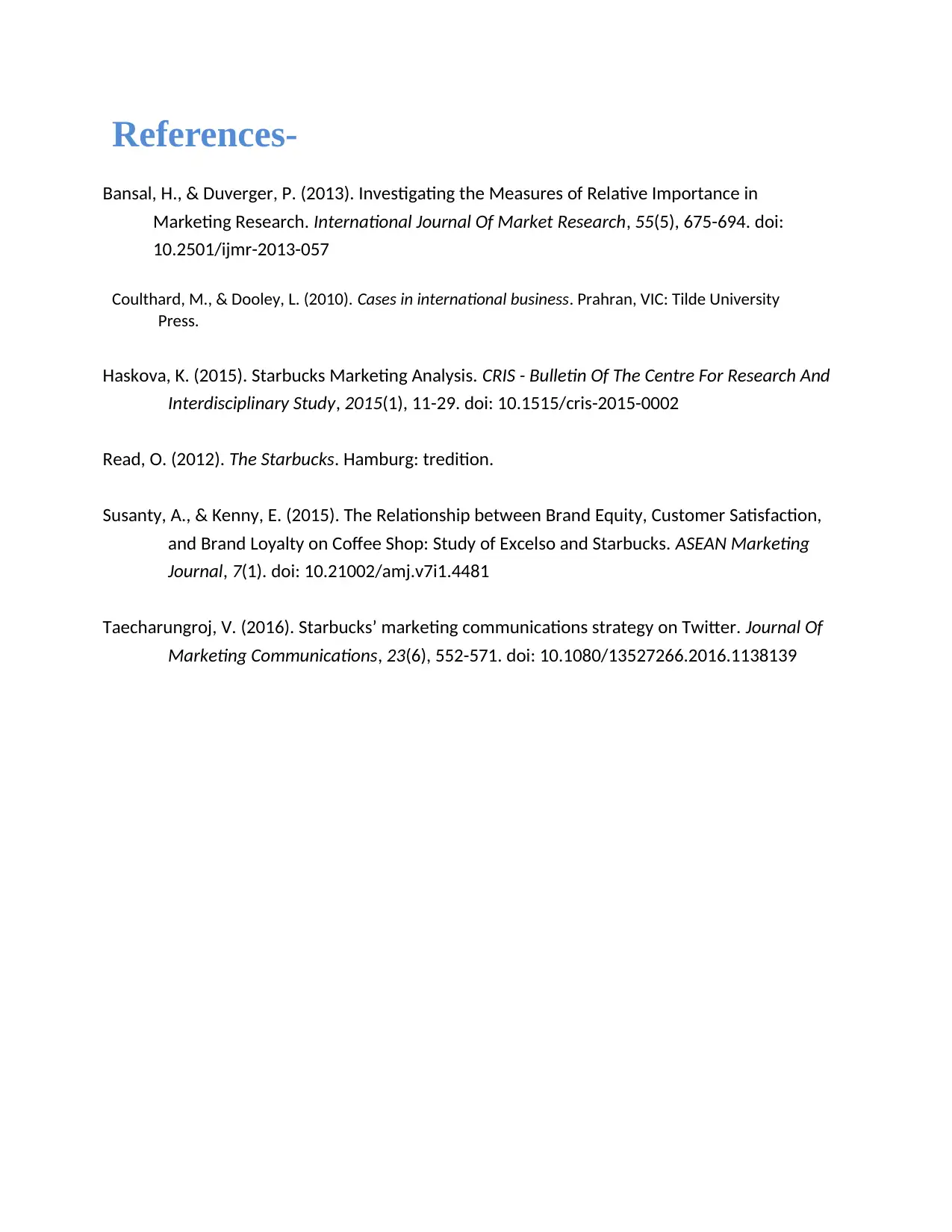A Case Study on Managing Organizational Change: Starbucks in Australia
VerifiedAdded on 2023/04/07
|4
|900
|221
Case Study
AI Summary
This case study examines Starbucks' unsuccessful market entry into Australia, highlighting the organizational changes and strategic missteps that led to the closure of numerous stores. Key issues included a failure to adapt to Australia's sophisticated coffee culture, an aggressive growth strategy unsuited to the local market, staff lacking the expertise of local baristas, and a misjudgment of customer perceptions regarding value and pricing. Starbucks also suffered from passive market coverage due to inexperienced employees and a lack of advertising, assuming brand reputation alone would suffice. The company's product taste and pricing failed to resonate with Australian consumers, who were already accustomed to high-quality, espresso-based coffee from local cafes. Desklib provides students access to past papers and solved assignments for further research.

Managing Organization Change
Paraphrase This Document
Need a fresh take? Get an instant paraphrase of this document with our AI Paraphraser

Starbucks is a big coffee brand and we can easily find a Starbucks café almost everywhere in the
world except in Australia. The reason behind this is the shutdown of 70 percent of its
underperforming stores. Now, there are only 39 Starbucks stores in the whole continent. The
first Starbucks store started in Australia was in 2000 and it has been grown so fast. There was a
strong coffee- culture in Australia and it was also declared as a challenge for Starbucks.
Australians did not like the taste of Starbucks and preferred to go to the local cafes that charge
comparatively lower than Starbucks. In the starting, it made an accumulate loss of $105 million
dollars and then Starbucks decided to close its 61 stores.
There are many other key issues and problems that Starbucks has faced while operating in
Australia-
1. Coffee culture- Australia has a very sophisticated coffee culture and Starbucks has never
focused on this concern. Australian café market and New Zealand market are 100%
espresso-based market and it is highly dominated by the filter style and brewed coffee.
Australia is a country that is known for its customers that possess a very different taste
in espresso- based coffees. So, it is clear that it was a very difficult task for Starbucks to
enter into the Australian market (Haskova, 2015).
2. Aggressive Growth Strategy- Starbucks has the same strategy for al the market but every
market is not similar. Starbucks has used its original strategy in Australia too and this
was not right. Success story of Starbucks was the fact that in earlier markets, there was
no tradition of European coffee and Starbucks has introduced the same. Australia has an
amazing coffee culture and when any new competitor enters into the market then it has
to face a strong competition (Bansal & Duverger, 2013).
3. Staff Differences- In Australia, people had a perception that staff work in Starbucks is
not that much knowledgeable in comparison to small brands and boutique coffee shops.
It was difficult for the Australians to understand the American coffee brand and taste of
its coffee. This perception was one of the reasons of failure of Starbucks in Australia.
4. Understanding of Market- Starbucks did a mistake in overestimating the brand and way
how customer perceived its value. Many Australians that were residing in the cities that
already have a big coffee culture tried Starbucks coffee and they were really failed to
world except in Australia. The reason behind this is the shutdown of 70 percent of its
underperforming stores. Now, there are only 39 Starbucks stores in the whole continent. The
first Starbucks store started in Australia was in 2000 and it has been grown so fast. There was a
strong coffee- culture in Australia and it was also declared as a challenge for Starbucks.
Australians did not like the taste of Starbucks and preferred to go to the local cafes that charge
comparatively lower than Starbucks. In the starting, it made an accumulate loss of $105 million
dollars and then Starbucks decided to close its 61 stores.
There are many other key issues and problems that Starbucks has faced while operating in
Australia-
1. Coffee culture- Australia has a very sophisticated coffee culture and Starbucks has never
focused on this concern. Australian café market and New Zealand market are 100%
espresso-based market and it is highly dominated by the filter style and brewed coffee.
Australia is a country that is known for its customers that possess a very different taste
in espresso- based coffees. So, it is clear that it was a very difficult task for Starbucks to
enter into the Australian market (Haskova, 2015).
2. Aggressive Growth Strategy- Starbucks has the same strategy for al the market but every
market is not similar. Starbucks has used its original strategy in Australia too and this
was not right. Success story of Starbucks was the fact that in earlier markets, there was
no tradition of European coffee and Starbucks has introduced the same. Australia has an
amazing coffee culture and when any new competitor enters into the market then it has
to face a strong competition (Bansal & Duverger, 2013).
3. Staff Differences- In Australia, people had a perception that staff work in Starbucks is
not that much knowledgeable in comparison to small brands and boutique coffee shops.
It was difficult for the Australians to understand the American coffee brand and taste of
its coffee. This perception was one of the reasons of failure of Starbucks in Australia.
4. Understanding of Market- Starbucks did a mistake in overestimating the brand and way
how customer perceived its value. Many Australians that were residing in the cities that
already have a big coffee culture tried Starbucks coffee and they were really failed to

understand the high prices of the outlet (Susanty & Kenny, 2015). It is easy to set up in the
market where there is already a coffee culture. This also helps the new brand to
understand market conditions and growth prospect of the brand. Starbucks high prices are
still a big issue for low sales.
5. Passive market coverage- Due to the fast coverage of market, Starbucks appointed less
experienced employees due to which its number of stores really suffered. Australia’s
population is so particular about the coffee taste and they did not like the brand.
Starbucks could have saved the stores, if employees hired were trained enough and
maintained the standards of coffee (Taecharungroj, 2016).
6. Product Taste and Pricing- Taste of the product and its pricing play a very important role
when it gets start at any new location (Coulthard & Dooley, 2010). Taste of Australians
for coffee was very different from the Americans as In Australia; there was a very strong
coffee culture even before Starbucks entered in the Australian market. Starbucks failed
in its pricing strategy as well as to make the product suitable for that particular market.
7. Advertisement- As there was a very high competition for coffee in the Australian
market, there is a high need of advertisement if any player enters into the market.
Starbucks did not advertise about the brand in mass media as it was quite sure about
the reputation of the brand. ‘Advertise the brand’ was against the corporate ethos of
Starbucks but they should have done advertisement to make people know about the
product. People in Australia are very much loyal to the brand and they prefer to choose
Barista instead of Starbucks (Read, 2012).
Starbucks should focus more on its pricing strategy as there is a drop in sales at many locations
because of its high prices. There are some brands available in market that is providing coffee in
very reasonable prices like CCD. Every market is different so as the taste and preference of the
customers so Starbucks should create a different growth strategy for different markets. It has a
big brand image in the American market and it is important to maintain the quality of services
and staff in other regions as well.
market where there is already a coffee culture. This also helps the new brand to
understand market conditions and growth prospect of the brand. Starbucks high prices are
still a big issue for low sales.
5. Passive market coverage- Due to the fast coverage of market, Starbucks appointed less
experienced employees due to which its number of stores really suffered. Australia’s
population is so particular about the coffee taste and they did not like the brand.
Starbucks could have saved the stores, if employees hired were trained enough and
maintained the standards of coffee (Taecharungroj, 2016).
6. Product Taste and Pricing- Taste of the product and its pricing play a very important role
when it gets start at any new location (Coulthard & Dooley, 2010). Taste of Australians
for coffee was very different from the Americans as In Australia; there was a very strong
coffee culture even before Starbucks entered in the Australian market. Starbucks failed
in its pricing strategy as well as to make the product suitable for that particular market.
7. Advertisement- As there was a very high competition for coffee in the Australian
market, there is a high need of advertisement if any player enters into the market.
Starbucks did not advertise about the brand in mass media as it was quite sure about
the reputation of the brand. ‘Advertise the brand’ was against the corporate ethos of
Starbucks but they should have done advertisement to make people know about the
product. People in Australia are very much loyal to the brand and they prefer to choose
Barista instead of Starbucks (Read, 2012).
Starbucks should focus more on its pricing strategy as there is a drop in sales at many locations
because of its high prices. There are some brands available in market that is providing coffee in
very reasonable prices like CCD. Every market is different so as the taste and preference of the
customers so Starbucks should create a different growth strategy for different markets. It has a
big brand image in the American market and it is important to maintain the quality of services
and staff in other regions as well.
⊘ This is a preview!⊘
Do you want full access?
Subscribe today to unlock all pages.

Trusted by 1+ million students worldwide

References-
Bansal, H., & Duverger, P. (2013). Investigating the Measures of Relative Importance in
Marketing Research. International Journal Of Market Research, 55(5), 675-694. doi:
10.2501/ijmr-2013-057
Coulthard, M., & Dooley, L. (2010). Cases in international business. Prahran, VIC: Tilde University
Press.
Haskova, K. (2015). Starbucks Marketing Analysis. CRIS - Bulletin Of The Centre For Research And
Interdisciplinary Study, 2015(1), 11-29. doi: 10.1515/cris-2015-0002
Read, O. (2012). The Starbucks. Hamburg: tredition.
Susanty, A., & Kenny, E. (2015). The Relationship between Brand Equity, Customer Satisfaction,
and Brand Loyalty on Coffee Shop: Study of Excelso and Starbucks. ASEAN Marketing
Journal, 7(1). doi: 10.21002/amj.v7i1.4481
Taecharungroj, V. (2016). Starbucks’ marketing communications strategy on Twitter. Journal Of
Marketing Communications, 23(6), 552-571. doi: 10.1080/13527266.2016.1138139
Bansal, H., & Duverger, P. (2013). Investigating the Measures of Relative Importance in
Marketing Research. International Journal Of Market Research, 55(5), 675-694. doi:
10.2501/ijmr-2013-057
Coulthard, M., & Dooley, L. (2010). Cases in international business. Prahran, VIC: Tilde University
Press.
Haskova, K. (2015). Starbucks Marketing Analysis. CRIS - Bulletin Of The Centre For Research And
Interdisciplinary Study, 2015(1), 11-29. doi: 10.1515/cris-2015-0002
Read, O. (2012). The Starbucks. Hamburg: tredition.
Susanty, A., & Kenny, E. (2015). The Relationship between Brand Equity, Customer Satisfaction,
and Brand Loyalty on Coffee Shop: Study of Excelso and Starbucks. ASEAN Marketing
Journal, 7(1). doi: 10.21002/amj.v7i1.4481
Taecharungroj, V. (2016). Starbucks’ marketing communications strategy on Twitter. Journal Of
Marketing Communications, 23(6), 552-571. doi: 10.1080/13527266.2016.1138139
1 out of 4
Related Documents
Your All-in-One AI-Powered Toolkit for Academic Success.
+13062052269
info@desklib.com
Available 24*7 on WhatsApp / Email
![[object Object]](/_next/static/media/star-bottom.7253800d.svg)
Unlock your academic potential
Copyright © 2020–2025 A2Z Services. All Rights Reserved. Developed and managed by ZUCOL.





